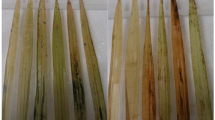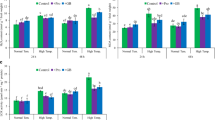Abstract
The aim of our study was to examine whether exogenously applied with gallic acid (GA) enhances the tolerance of rice cultivars to polyethylene glycol (PEG)-induced osmotic stress or salt (NaCl) stress. After two Oryza sativa L. cultivars, tolerant cultivar Pokkali and sensitive cultivar IR-28, were hydroponically-grown for 3 weeks, seedlings were treated with GA (0.75 and 1.5 mM), 120 mM NaCl and 20 % PEG-6000 producing the same osmotic potential (−0.5 MPa) and GA and stress combination for 72 h. PEG had greater reduction in growth rate (RGR) and water content (RWC) than that of NaCl in both cultivars. Salt and PEG decreased the maximum photochemical efficiency (Fv/Fm), the photochemical quenching coefficient (qP) and the actual quantum yield (ΦPSII), even more pronounced at NaCl in IR-28. Also, a notable increase in lipid peroxidation (TBARS) and hydrogen peroxide (H2O2) content was observed with PEG as compared to NaCl treatment. Activities of superoxide dismutase (SOD), ascorbate peroxidase (APX) and glutathione reductase in Pokkali and, catalase (CAT) and peroxidase (POX) in IR-28 were induced to a greater extent by PEG. The sensitivity of plants to stress was higher in IR-28 than in Pokkali. Also, comparing the injury between the NaCl and PEG stresses, it was greater under PEG-mediated osmotic stress. However, compared with the stress-treated plants alone, GA added to NaCl-stressed Pokkali significantly decreased H2O2 and TBARS contents, and enhanced the activities of SOD, CAT, POX and APX as well as increase of RGR, osmotic potential (ΨΠ), Fv/Fm and proline. In PEG-treated IR-28, GA strongly suppressed H2O2 and TBARS contents, up-regulated SOD and APX activities and increased RGR, RWC and ΨΠ. It could be concluded that the both GA concentrations alleviated NaCl and PEG toxicity by increased the level of antioxidant activity and photosynthetic efficiency in rice.








Similar content being viewed by others
References
Ai L, Li ZH ZX, Xıe Tian XL, Eneji AE, Duan LH (2008) Coronatine alleviates polyethylene glycol-induced water stress in two rice (Oryza sativa L.) cultivars. J Agron Crop Sci 194:360–368
Ashraf M, Foolad MR (2007) Improving plant abiotic-stress resistance by exogenous application of osmoprotectants glycine betaine and proline. Environ Exp Bot 59(2):206–216
Basu S, Roychoudhury A, Saha PP, Sengupta DN (2010) Differential antioxidative responses of indica rice cultivars to drought stress. Plant Growth Regul 60:51–59
Bates L, Waldrenn R, Teare I (1973) Rapid determination of free proline for water-stress studies. Plant Soil 39:205–207
Baziramakenga R, Leroux GD, Simard RR (1995) Effects of benzoic and cinnamic acids on membrane permeability of soybean roots. J Chem Ecol 21:1271–1285
Beauchamp C, Fridovich I (1971) Superoxide dismutase: improved assays and an assay applicable to acrylamide gels. Anal Biochem 44:276–287
Bergmeyer N (1970) Methoden der enzymatischen analyse. Akademie Verlag, Berlin
Bradford MM (1976) A rapid and sensitive method for the quantization of microgram quantities of protein utilizing the principle of the protein-dye binding. Anal Biochem 72:248–254
Cha-um S, Supaibulwatana K, Kirdmanee C (2007) Glycinebetaine accumulation, physiological characterizations and growth efficiency in salt-tolerant and salt-sensitive lines of indica rice (Oryza sativa L. ssp. indica) in response to salt stress. J Agron Crop Sci 193:157–166
Foyer CH, Halliwell B (1976) The presence of glutathione and glutathione reductase in chloroplast: a proposed role in ascorbic acid metabolism. Planta 133:21–25
Foyer CH, Noctor G (2000) Oxygen processing in photosynthesis: regulation and signalling. New Phytol 146:359–388
Gandhi NM, Nair CKK (2005) Protection of DNA and membrane from gamma radiation induced damage by gallic acid. Mol Cell Biochem 278(1–2):111–117
Herzog V, Fahimi H (1973) Determination of the activity of peroxidase. Anal Biochem 55:554–562
Heyser JW, Nabors MW (1981) Growth water content, and solute accumulation of two tobacco cell lines cultured on sodium chloride, dextran, and polyethylene glycol. Plant Physiol 68:1454–1459
Holapp L, Blum U (1991) Effects of exogenously applied ferulic acid, a potential allelopathic compound, on leaf growth, water utilization, and endogenous abscisic acid levels of tomato, cucumber, and bean. J Chem Ecol 17:865–886
Hou D, Fujii M, Terahara N, Yoshimoto M (2004) Molecular mechanisms behind the chemo preventive effects of anthocyanidins. J Biomed Biotechnol 5:321–325
Hunt R, Causton DR, Shipley B, Askew AP (2002) A modern tool for classical plant growth analysis. Ann Bot 90:485–488
Jia W, Zhang J (1999) Stomatal closure is induced rather by prevailing xylem abscisic acid than by accumulated amount of xylem-derived abscisic acid. Plant Physiol 106:268–275
Jiang M, Zhang J (2002) Involvement of plasma membrane NADPH oxidase in abscicic acid and water stress-induced antioxidant defense in leaves of maize seedlings. Planta 215:1022–1030
Jones MA, Raymond MJ, Yang Z, Smirnoff N (2007) NADPH oxidase-dependent reactive oxygen species formation required for root hair growth depends on ROP GTPase. J Exp Bot 58:1261–1270
Laemmli UK (1970) Cleavage of structural proteins during the assembly of the head of bacteriophage T4. Nature 227:680–685
Liu ZJ, Guo YK, Bai JG (2010) Exogenous hydrogen peroxide changes antioxidant enzyme activity and protects ultrastructure in leaves of two cucumber ecotypes under osmotic stress. J Plant Growth Regul 29:171–183
Lokhande VH, Nikam TD, Suprasanna P (2010) Differential osmotic adjustment to iso-osmotic salt and PEG stress in vitro in the halophyte Sesuvium portulacastrum L. J Crop Sci Biotechnol 13:251–256
Madhava Rao KV, Sresty TVS (2000) Antioxidative parameters in the seedlings of pigeon pea [Cajanus cajan (L.) Millspaugh] in response to Zn and Ni stresses. Plant Sci 157:113–128
Mishra RP, Singh RK, Jaiswal HK, Kumar V, Maurya S (2006) Rhizobium-mediated induction of phenolic and plant growth promotion in rice (Oryza sativa L.). Curr Microbiol 52:383–389
Mishra JS, Subbarayudu B, Chapke RR, Seetharama N (2011) Evaluation of sorghum (Sorghum bicolor) cultivars in rice (Oryza sativa)-fallows under zero-tillage. Indian J Agric Sci 81(3):277–279
Mittler R (2002) Oxidative stress, antioxidants and stress tolerance. Trends Plant Sci 7:405–410
Mittler R, Zilinskas BA (1993) Detection of ascorbate peroxidase activity in native gels by inhibition of the ascorbate dependent reduction of nitroblue tetrazolium. Anal Biochem 212:540–546
Moradi F, Ismail AM, Gregorio GB, Egdane JA (2003) Salinity tolerance of rice during reproductive development and association with tolerance at the seedling stage. Indian J Plant Phys 8:276–287
Morton LW, Caccetta RAA, Puddey IB, Croft KD (2000) Chemistry and biological effects of dietary phenolic compounds: relevance to cardiovascular disease. Clin Exp Pharmacol Physiol 27:52–59
Munns R (2002) Comparative physiology of salt and water stress. Plant, Cell Environ 25:239–250
Murillo-Amador B, Lopez-Aguilar R, Kaya C, Larrinaga-Mayoral J, Flores-Hernandez A (2002) Comparative effects of NaCl and polyethylene glycol on germination, emergence and seedling growth of cowpea. J Agron Crop Sci 188:235–247
Nakano Y, Asada K (1981) Hydrogen peroxide is scavenged by ascorbate-specific peroxidase in spinach chloroplasts. Plant Cell Physiol 22:867–880
Niemetz R, Gross GG (2005) Enzymology of gallotannin and ellagitannin biosynthesis. Phytochemistry 66:2001–2011
Noctor G, Foyer CH (1998) Ascorbate and glutathione: keeping active oxygen under control. Annu Rev Plant Physiol 49:249–279
Patade VY, Rai AN, Suprasanna P (2011) Expression analysis of sugarcane shaggy-like kinase (SuSK) gene identified through cDNA subtractive hybridization in sugarcane (Saccharum officinarum L.). Protoplasma 248(3):613–621
Sagi M, Fluhr R (2001) Superoxide production by plant homologues of the gp91(phox) NADPH oxidase. Modulation of activity by calcium and by tobacco mosaic virus infection. Plant Physiol 126(3):1281–1290
Seevers FM, Daly JM, Catedral FF (1971) The role of peroxidase isozymes in resistance to wheat stem rust. Plant Physiol 48:353–360
Senadheera P, Tirimanne S, Maathuis FJM (2012) Long term salinity stress reveals cultivar specific differences in root oxidative stress response. Rice Sci 19:36–43
Sgherri C, Cosi E, Navari-Izzo F (2003) Phenols and antioxidative status of Raphanus sativus grown in copper excess. Plant Physiol 118:21–28
Shabani A, Sepaskhah AR, Kamgar-Haghighi AA (2013) Growth and physiologic response of rapeseed (Brassica napus L.) to deficit irrigation, water salinity and planting method. IJJP 7:569–596
Smart RE, Bingham GE (1974) Rapid estimates of relative water content. Plant Physiol 53:258–260
Storey R, Wyn Jones RG (1978) Salt stress and comparative physiology in the Gramineae. I. Ion relations of two salt- and water-stressed barley cultivars, California Mariout and Arimar. Aust J Plant Physiol 5:801–816
Sucre B, Suarez N (2011) Effect of salinity and PEG-induced water stress on water status, gas exchange, solute accumulation and leaf growth in Ipomoea pes-caprae. Environ Exp Bot 2(3):192–203
United Nations (1999) World population prospects: the 1998 revision. vol. 1: comprehensive tables. United Nations, New York
Vitória AP, Lea PJ, Azevedo RA (2001) Antioxidant enzymes responses to cadmium in radish tissues. Phytochemistry 57:701–710
Wang WB, Kim YH, Lee HS, Kim KY, Deng XP, Kwak SS (2009) Analysis of antioxidant enzyme activity during germination of alfalfa under salt and drought stresses. Plant Physiol Biochem 47(7):570–577
Woodbury W, Spencer AK, Stahman MA (1971) An improved procedure for using ferricyanide for detecting catalase isozymes. Anal Biochem 44:301–305
Yeh CT, Yen GC (2006) Induction of hepatic antioxidant enzymes by phenolic acids in rats is accompanied by increased levels of multidrug resistance-associated protein 3 mRNA expression. J Nutr 136(1):11–15
Acknowledgments
Financial support for this work was provided by Necmettin Erbakan University Scientific Research Projects Coordinating Office (Project Number: 121215001).
Author information
Authors and Affiliations
Corresponding author
Rights and permissions
About this article
Cite this article
Ozfidan-Konakci, C., Yildiztugay, E. & Kucukoduk, M. Protective roles of exogenously applied gallic acid in Oryza sativa subjected to salt and osmotic stresses: effects on the total antioxidant capacity. Plant Growth Regul 75, 219–234 (2015). https://doi.org/10.1007/s10725-014-9946-4
Received:
Accepted:
Published:
Issue Date:
DOI: https://doi.org/10.1007/s10725-014-9946-4




